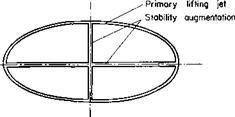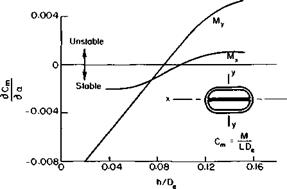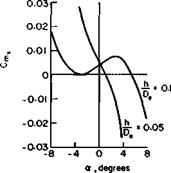Static Stability and Control of a GEM
One of the problems of a GEM is its marginal inherent handling quality. A pure peripheral jet exhibits a slight stability in pitch at very low heights. However, this stability deteriorates rapidly as the height is increased above
|
Fig. 12-8. Subdivision of GEM base to improve stability. |
approximately 10% of the diameter. The GEM is inherently stable in heave; that is, as the height tends to increase, the decreasing lift drops the machine back to its trimmed height. Obviously, if we attached several small machines together at the end of a boom, the result would be stable both in heave and pitch. This is essentially the scheme by which the pitch stability of GEM’s is improved. Additional slots are cut in the base to divide the machine effectively into a number of smaller machines capable of sustaining different pressures under different portions of the base. Such a method is shown schematically in Fig. 12-8. The effect of subdivision of the base on the slope of the pitching moment curve with a is shown in Fig. 12-9. Here a stability slot has been installed along the x-axis only. Hence the stability is affected only about the x-axis. The result is a greater height for neutral stability about the x-axis than the y-axis.
|
|
|
Fig. 12-9. Effect of stability slot on static pitching moments: M = moment; L = lift; De = equivalent diameter; Dh4 = base area. |
This improvement in stability is not obtained free, however. Figure 12-10 shows the decrease in A as the result of adding inside slots.
Another somewhat similar scheme for improving the stability of a GEM is presented in Ref. 5. An inside jet is incorporated to parallel the outer jet, as shown in Fig. 12-11. According to the reference, the normal distance between the two slots should be twice the height of the base above the ground in order to provide satisfactory stability.
The control of GEM’s can be accomplished either by diverting some of
0C
![]()
![]()
![]()
![]()
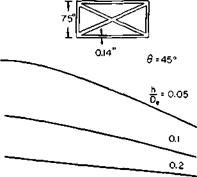 с
с
■З 4
О
с
<D
Є
з
<
 |
Fig. 12-10. Effect of stability slots on thrust augmentation ratio.
the air applied to the base or by providing sources of separate thrusts such as external propellers. The second scheme seems to be gaining favor, as the control forces available with the base air are somewhat limited. Variations include a steerable propeller, ducted or open, and a fixed-propeller with movable control surfaces in its slipstream.
Problems
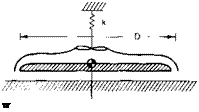 |
1. Given a circular peripheral-jet ground-effect machine of weight W suspended on a spring of constant k, assume h small in comparison with
D and small vertical excursions about a trimmed value of h. Derive an expression for the natural frequency of vertical oscillation.
[1] Bracketed numbers refer to references.
[2] single
Because df is approximately 1.8, this represents an increase of 90% in the induced power of the tandem configuration over that required by the single rotor. Fortunately, the induced power varies inversely with the velocity so that the increase, as a percentage of the total power, is not nearly so severe. Consider the single rotor example calculated above. By excluding the stall and compressibility corrections to make a more realistic comparison, we can see that a 90% increase in the induced power represents only a 13.5% increase in the total power.
Of course, some of this power is regained by the tandem in the form of decreased parasite power, because the tandem, loaded fore and aft, presents a fuselage shape with a smaller parasite drag than a single rotor helicopter











